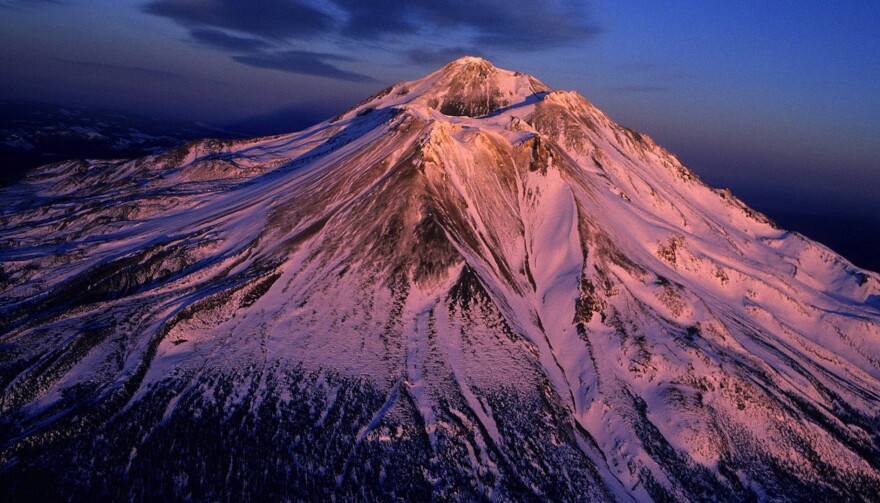“Lonely as God and white as a winter moon.” That’s how 19th-century writer Joaquin Miller described Mount Shasta, California’s most majestic mountain. So it still is.
Shasta is California’s fifth-highest peak but more impressive than any other—perpetually snow-covered, glowing orange, pink, and purple at sunset, casting shadows on the lava lands below. Sometimes clearly visible from as far away as 150 miles, close up Shasta is more obscure, mysterious.
Native people revere Shasta as the abode of the Great Spirit. Others, too, attribute special power to the great mountain. Buddhists, Tibetan shamans, Christians of all stripes. Rosicrucians and the Lemurians they made famous, remnants of the lost continent of Lemuria.

A National Natural Landmark, Mount Shasta is the highest point in California’s Cascades, and the largest volcano in the contiguous 48 states. Mount Whitney is taller by 332 feet, and other mountains are bigger by other measurements, but their grandeur is lost among so many lofty peaks. Not so Shasta, which stands alone at 14,162 feet and towers almost 10,000 feet above the surrounding countryside. Lonely as God, white as a winter moon.
There is always snow on Shasta. Hikers and backpackers walk up into it via forest trails from spring to early September, but only fit and fairly climbers get to the top. The truly intrepid climb any time.
A Yreka merchant, E.D. Pearce, is credited with the first ascent. Scientists first braved the mountain in 1862, when Josiah Whitney led a Geological Survey party to the summit. When they got to the top, they found tin cans, broken bottles, a Methodist hymnbook, a newspaper, a pack of cards, “and other evidences of bygone civilization.”
John Muir, founder of the Sierra Club, first climbed Shasta on Nov. 1, 1874, and was enchanted. Waking up the next day he saw:
. . . a boundless wilderness of storm clouds of different degrees of ripeness . . . congregated over all the lower landscapes for thousands of square miles, colored gray, and purple, and pearl, and deep-glowing white, amid which I seemed to be floating, while the great white cone of the mountain above was all aglow in the free, blazing sunshine.

The storm Muir watched forming soon hit, forcing him to shelter in a spruce grove for five days. The following year he made two trips up Shasta, an uneventful April 28 climb and a nearly fatal ascent just two days later.
Caught in a savage snowstorm, Muir and his guide kept from freezing by burrowing into the hot mud of the sulfur springs at the summit—each alternately scalding one side of his body and losing all sensation in the other. Black Butte, near I-5, was once called Muir Peak in the mountain man’s honor.
Non-climbers, take the highway up the mountainside to where the road ends. From there, 8,000 feet up, you can see the entire north end of the Sacramento Valley, Burney Falls, Lassen Park, the Trinity Alps, Castle Crags, the Sacramento River canyon, and Lake Siskiyou below.





